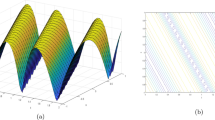Abstract
The goal of this paper is spectral analysis of an evolutionary semigroup generator describing the dynamics of a rarefied two-component plasma subjected to a self-consistent electromagnetic field. For the problem in question, the spectrum is given in terms of the dispersion relationship and an effective approach to the calculation of the instability index is developed.
Similar content being viewed by others
This paper deals with spectral analysis of a dynamical system representing a kinetic model of a rarefied two-component plasma consisting of particles of two types, namely, electrons and ions subjected to an electromagnetic field. The particle distribution in the phase space is characterized by distribution densities depending on time t and the coordinates and velocities of the particles. The system describing the dynamics of the plasma consists of Maxwell’s equations for the electromagnetic field components and Boltzmann kinetic equations for the distribution densities.
In the collisionless approximation considered below, the charged particles interact via a self-consistent electromagnetic field, which, on the one hand, is induced by the motion of the charged particles and, on the other hand, affect the evolution of their distribution densities. By using this mathematical model, an unexpected phenomenon was found in [1], namely, wave damping in a collisionless plasma. This subject has been extensively studied by both physicists and mathematicians (see [2–6] and bibliography therein). Our goal is to perform spectral analysis of an integro-differential operator generating an evolutionary semigroup describing the dynamics of an initial perturbation of the stationary solution to the system (cf. [7, 8]).
For presentational simplicity, we consider a two-dimensional single-particle phase space \((x,v)\) when the magnetic field \(B(t,x)\) is degenerate. Then the considered system of equations has the form
where e and Ze are charges; m and M are the masses of electron and ion, respectively; \({{f}^{{( \mp )}}}\) are their distribution densities; and \(E = E(t,x)\) is the electric field strength. Each of the kinetic equations can be written in the Liouville form (see [9]) and means that the total derivative of the distribution density along the trajectory of a particle of the corresponding type is zero. Stationary solutions of the kinetic equations have the form
where ϕ(x) is the electrostatic potential, i.e., \(E = - \frac{{\partial \phi }}{{\partial x}}.\) Below, by the unperturbed solution of the system, we mean its stationary solution independent of the spatial coordinate (cf. [10]).
Following [4], we assume that the ion distribution density \(f_{0}^{{( + )}}\left( {\frac{{m{{v}^{2}}}}{2}} \right)\) is fixed. Linearizing the system about the corresponding stationary solution yields the system
where \(f = f(t,x,{v})\) is the perturbation of the stationary electron distribution density \({{f}_{0}}({v})\)\( = f_{0}^{{( - )}}\left( {\frac{{m{{{v}}^{2}}}}{2}} \right),\) and \(E(t,x)\) is the strength of the induced electric field. The perturbation of the particle distribution density and the electric field are assumed to decay rather quickly to zero at infinity.
The generator of the arising operator semigroup acts according to the formula
where the function \(\varphi ({v}) = \frac{{4\pi {{e}^{2}}}}{m}f\,{{'}_{0}}({v})\) satisfies the condition
The operator T acts on basic space defined according to the physical formulation of the problem as the space of vector functions \((f(x,{v}),g(x))\) with a finite norm
The structure and localization of the spectrum of T in terms of the functional parameter φ of the problem under consideration is explicitly described in the following result.
Theorem 1. Provided that the moment
is finite, the spectrum \(\sigma (T)\)of the operator T consists of the following two components:
where
The proof relies on a well-known operator-theoretic fact (see, e.g., [11]): for operator matrices acting in the direct sum \(X \oplus Y\) of Banach spaces, it is true that
where \(A{\kern 1pt} :\;X \to X\) is an invertible operator; \(B{\kern 1pt} :\;Y \to X\) and \(C{\kern 1pt} :\;X \to Y\) are bounded operators; I and J are the identity operators in X and Y, respectively; and the expression \(D - C{{A}^{{ - 1}}}B\) is called the Schur complement associated with \(A.\)
Proposition 1. A point \(\lambda \not\in \sigma (A)\)belongs to the resolvent set of the operator matrix (3) acting in \(X \oplus Y\)if and only if the corresponding Schur complement
is boundedly invertible in Y.
As applied to the situation under consideration, we set
and define the components of the block matrix
acting in \(X \oplus Y\) as follows: the operator \(A = - v\frac{\partial }{{\partial x}}\) acts in X and has the dense domain \(\{ f \in X{\text{:}}\,\,f( \cdot ,v)\) is absolutely continuous, \(\frac{{v\partial f}}{{\partial x}} \in X\} ,\)\(C = \int\limits_\mathbb{R} {\; \cdot \;vdv} \), and B is the operator of multiplication by a locally bounded function \(\varphi (v)\) satisfying conditions (1) and (2). A key element of the proof of Theorem 1 is the following result.
Proposition 2. Under conditions (1) and (2), the spectrum of the operator \(T\)consists of two components:
where \(\sigma (A) = i\mathbb{R}\)and the normalized Schur complement
in the Fourier representation with respect to \(x\)acts as multiplication by the function \(\Delta (k,\lambda ).\)
The results concerning the localization of the spectrum of the problem, established in [4], are supplemented and refined by the following assertion.
Corollary 1. The resolvent set of the operator T contains the domain
In the physics literature (see, e.g., [2]), the equation \(\Delta (k,\lambda ) = 0\) is known as the Landau dispersion relationship. It determines the values of spectral parameter \(\lambda \) and wavenumber k for which the considered system has plane-wave solutions depending on t and x as \(\exp(\lambda t + ikx).\) If \({\text{Re}}\lambda > 0,\) then such solutions generate unstable modes associated with undamped plasma oscillations. An efficient method for calculating the instability index (cf. [12]) as applied to the problem under consideration is provided by the following result.
Theorem 2. Suppose that \(\varphi \in {{{\text{L}}}_{1}}(\mathbb{R})\), \(\varphi (v) \to 0\)as \(v \to \pm \infty ,\)the derivative \(\varphi '(v)\)is bounded, and all zeros of the function \(\varphi \)are nondegenerate. If for each zero s of \(\varphi \), the parameter \(k \in \mathbb{R}{\backslash }\{ 0\} \)satisfies the condition
then the number N(k) of roots \(\lambda = \lambda (k)\)of the equation \(\Delta (k,\lambda ) = 0\)that lie in the right half-plane is equal to the difference \({{N}_{ + }}(k) - {{N}_{ - }}(k),\)where
It is convenient to describe the proof sketch if we use the function
whose boundary values on the real line are given by the Sokhotskij–Plemelj formulas
According to the argument principle (see, e.g., [13]), given an arbitrary closed contour \(\gamma \subset {{\mathbb{C}}_{ + }}\) enclosing all zeros of \(w(z)\) lying in \({{\mathbb{C}}_{ + }},\) the total number \(N = N(k)\) of these zeros is equal to the sum of the logarithmic residues of \(w(z)\) in the domain bounded by γ. This quantity is the index of the point w = 0 with respect to the curve \(\Gamma = w(\gamma )\) and coincides with the rotation number, i.e., with the number of revolutions around zero made by the radius vector w when Γ is traversed in a positive direction:
This method for calculating the number of roots of the dispersion relationship agrees with the well-known Nyquist criterion (see [2]), whose applicability to the plasma stability/instability problem was rigorously substantiated in [14].
In the considered case, γ is defined as the contour consisting of the segment [–R, R] and a half-circle arc of radius R such that the image of the half-circle belongs to a sufficiently small neighborhood of the point w = 1 bounded away from zero. As the point w moves along the closed curve \(\Gamma = w(\gamma )\), the segment between its two consecutive intersections with the negative half-line that correspond to the zeros s = \({{s}_{j}} \in [ - R,R]\), \(j = 1, \ldots ,n\), of \(\varphi (s)\) numbered in increasing order yields the increment of the argument
therefore, the index of w = 0 with respect to Γ is given by the formula
Condition (4) means that, on the imaginary axis, the dispersion relationship \(\Delta (k,\lambda )\) = 0 has no roots corresponding to the given \(k \in \mathbb{R}{\backslash }\{ 0\} \).
Corollary 2. Under the assumptions of Theorem 2, the equation \(\Delta (k,\lambda ) = 0\)has no roots in the right half-plane if
It is well known that a simple sufficient condition guaranteeing the lack of unstable plasma oscillations is formulated in terms of \({{f}_{0}}(v)\) (see [2, 4]). Namely, if \({{f}_{0}}(v)\) has a single extremum (maximum) \(v = a\), then the dispersion relationship has no roots \(\lambda = \lambda (k)\) in the right half-plane. Indeed, in this case, \(\frac{{\varphi (v)}}{{v - a}} < 0\) and, hence, \({{N}_{ + }}(k) = {{N}_{ - }}(k) = 0\) for \(k \ne 0,\) since
If \({{f}_{0}}(v)\) has two maxima, two-stream instability can arise (see [2]). As a model case, we consider the situation when \({{f}_{0}}(a) = {{f}_{0}}(b) = M\) is the maximum value of the function \({{f}_{0}}(v)\) and \(c \in (a,b)\) is its minimizer such that \({{f}_{0}}(c) = 0.\) Then \({{N}_{ - }}(k) = 0\) and a criterion for two-stream instability is provided by the following result.
Proposition 3. For a given \(k \in \mathbb{R}{\backslash }\{ 0\} \), we have \(N(k) = {{N}_{ + }}(k)\)= 1 if and only if
Below, sufficient conditions for the existence of unstable modes are formulated in terms of the arrangement and values of the maxima of the unperturbed distribution function. To this end, for the extremum point \(v = a\) and a fixed \(\xi \in (0,M)\), we set
Note that \(({{a}_{ > }}(\xi ) - {{a}_{ < }}(\xi ))\) is the width of the local maximum at the level ξ. Similar notation \({{b}_{ < }}(\eta )\) and \({{b}_{ > }}(\eta )\) is introduced for the extremum point \({v} = b.\)
Corollary 3. Suppose that, for some \(\xi ,\eta \in (0,M)\), it is true that
where \({{a}_{ > }} = {{a}_{ > }}(\xi )\), \({{a}_{ < }} = {{a}_{ < }}(\xi )\), \({{b}_{ > }} = {{b}_{ > }}(\eta )\), \({{b}_{ < }} = {{b}_{ < }}(\eta )\), and \(k \ne 0.\)Then \(N(k) = 1.\)
Below a somewhat different (in form) sufficient condition for instability is given.
Corollary 4. If, for some \(\sigma \in (0,c - a)\)and \(\tau \in (0\), b – c), one has
then, in the half-plane \({\text{Re}}\lambda > 0\), the equation \(\Delta (k,\lambda )\) = 0 has exactly one root \(\lambda = \lambda (k)\)corresponding to the given \(k \in \mathbb{R}{\backslash }\{ 0\} \).
The results of this paper can be extended to a six-dimensional single-particle phase space, in which case the Landau dispersion relationship has the form
where k is the wave vector and λ is the spectral parameter.
REFERENCES
L. D. Landau, Zh. Eksp. Teor. Fiz. 16, 574–586 (1946).
T. Stiks, Theory of Plasma Waves (Atomizdat, Moscow, 1965) [in Russian].
A. B. Mikhailovskii, Theory of Plasma Instability (Atomizdat, Moscow, 1970) [in Russian].
V. P. Maslov and M. V. Fedoryuk, Mat. Sb. 127 (4), 445–475 (1985).
A. A. Arsen’ev, Lectures on Kinetic Equations (Nauka, Moscow, 1992) [in Russian].
C. Mouhot and C. Villani, Acta Math. 207 (1), 29–201 (2011).
P. Degond, Trans. Am. Math. Soc. 294 (2), 435–453 (1986)
S. A. Stepin, Mat. Sb. 192 (1), 139–160 (2001).
V. V. Kozlov, Usp. Mat. Nauk 63 (4), 93–130 (2008).
S. I. Pokhozhaev, Differ. Equations 46 (4), 530–537 (2010).
P. R. Halmos, A Hilbert Space Problem Book (Springer-Verlag, New York, 1974).
S. A. Stepin, Dokl. Math. 89 (2), 202–205 (2014).
M. A. Lavrent’ev and B. V. Shabat, Methods of the Theory of Functions of a Complex Variable (Nauka, Moscow, 1973) [in Russian].
O. Penrose, Phys. Fluids 2 (2), 258–264 (1960).
Author information
Authors and Affiliations
Corresponding author
Additional information
Translated by I. Ruzanova
Rights and permissions
About this article
Cite this article
Stepin, S.A. Schur Complement and Continuous Spectrum in a Kinetic Plasma Model. Dokl. Math. 101, 231–234 (2020). https://doi.org/10.1134/S1064562420030217
Received:
Revised:
Accepted:
Published:
Issue Date:
DOI: https://doi.org/10.1134/S1064562420030217




